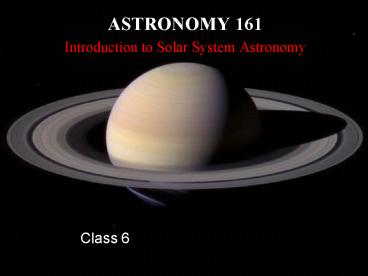ASTRONOMY 161 Introduction to Solar System Astronomy - PowerPoint PPT Presentation
1 / 34
Title:
ASTRONOMY 161 Introduction to Solar System Astronomy
Description:
Gather facts. Modify hypothesis Guess an explanation (Guess=hypothesis) Test hypothesis ... If you could observe Earth through a telescope from Mars, Earth would ... – PowerPoint PPT presentation
Number of Views:467
Avg rating:3.0/5.0
Title: ASTRONOMY 161 Introduction to Solar System Astronomy
1
ASTRONOMY 161Introduction to Solar System
Astronomy
Class 6
2
Tycho, Kepler, GalileoMonday, October 5
- E pur si muove! It still moves!
- - Galileo
3
Astronomical movies
- The Phases of Venus
- http//antwrp.gsfc.nasa.gov/apod/ap060110.html
- When Moons and Shadows Dance (Jupiter)
- http//antwrp.gsfc.nasa.gov/apod/ap030227.html
- Large Sunspot Group (Sun)
- http//antwrp.gsfc.nasa.gov/apod/ap010411.html
4
Tycho, Kepler, Galileo Key Concepts
- (1) Tycho Brahe made accurate measurements of
planetary motion. - (2) Planetary orbits are ellipses with the Sun at
one focus. - (3) A line between planet Sun sweeps out equal
areas in equal times. - (4) The square of a planets orbital period is
proportional to the cube of its average distance
from the Sun. - (5) Galileo made telescopic observations
supporting the heliocentric model.
5
(1) Tycho Brahe made accurate measurements of
planetary motion.
- Tycho Brahe (1546-1601) Danish astronomer
6
Tychos contributions to astronomy
- Tycho discovered new star, or nova, upsetting
ancient notion of perfect, unchanging heavens. - Made very accurate measurements of planetary
positions.
7
- Copernican system
8
- Tychos system
9
Johannes Kepler (1571-1630) German
- Was Tychos assistant.
- Used Tychos data to discover
- Three Laws of Planetary Motion.
10
(2) Keplers First Law
of planetary motion
- The orbits of planets around the Sun are ellipses
with the Sun at one focus.
11
Ellipse an oval built around two points, called
focuses (or foci).
- SIZE of ellipse
- Major axis longest diameter of ellipse.
- Semimajor axis half the major axis.
12
SHAPE of ellipse
- Eccentricity distance between foci divided by
major axis. - Foci close together ellipse nearly circular,
eccentricity close to zero. - Foci far apart ellipse very flattened,
eccentricity close to one.
13
Example Mars
- Semimajor axis 1.524 A.U.
- Eccentricity 0.093 (much smaller than one)
14
Ellipse comes from the family of Conic Sections
15
(3) Keplers
Second Law of planetary motion
- A line
from the Sun to a planet
sweeps out equal areas
in equal time intervals.
16
Consequences of Keplers Second Law
- Planets move fastest when closest to the Sun.
- Example Mars
- Perihelion 206,600,000 km (1.381 A.U.)
- Max. Orbital Speed 26.5 km/s
- Aphelion 249,200,000 km (1.666 A.U.)
- Min. Orbital Speed 22.0 km/s
17
(4) Keplers Third Law of
planetary motion
- The square of a planets orbital period is
proportional to the cube of its average distance
from the Sun - A planets average distance from the Sun is
equal to the semimajor axis of its orbit.
18
Keplers Third Law in mathematical form
- P orbital period (in years)
- a semimajor axis (in A.U.)
- Example The orbit of Mars
19
(5) Galileo made telescopic observations
supporting the heliocentric model.
- Galileo Galilei (1564-1642) Italian
- Galileo was among the first to observe the sky
with a telescope (1609).
20
(No Transcript)
21
Flashback to Class 1 What is Science?
- The SYSTEMATIC study of the Universe
- Gather facts
- Modify hypothesis Guess an
explanation - (Guesshypothesis)
- Test hypothesis
22
1) Mountains on the Moon
- Aristotle Ptolemy said the Moon is a perfect,
smooth sphere. - In fact, the Moon is no more perfect than the
Earth.
23
(No Transcript)
24
2) The Sun has spots on its surface.
- The Sun is not perfect.
- Motion of sunspots indicates that the Sun is
rotating. - If the Sun rotates, why not the Earth?
25
(No Transcript)
26
3) The planet Jupiter has moons of its own.
- Four Galilean moons of Jupiter Io, Europa,
Ganymede, Callisto. - The Earth is NOT the center of all orbits in the
universe.
27
(No Transcript)
28
(No Transcript)
29
4) Venus shows phases
like those of the Moon.
- Venus goes through all phases looks big when
nearly new, looks small when full. - Results consistent with Copernicus, inconsistent
with Ptolemy.
30
Phases of Venus in the
geocentric model of Ptolemy.
- Only new and crescent phases.
31
Phases of Venus in the
heliocentric model.
- All phases smaller angular size
when full than when new.
32
Few closing questions
- 1) Do the inner planets show retrograde motions?
(again) - 2) See picture on the right. What is it?
- 3) Does Mercury show phases? Mars? Jupiter?
33
(No Transcript)
34
Few closing questions continued
- 4) If the Sun is at one focus of the ellipse,
what is at the other focus? - 5) See picture on the right. What is it? Is it
real?































